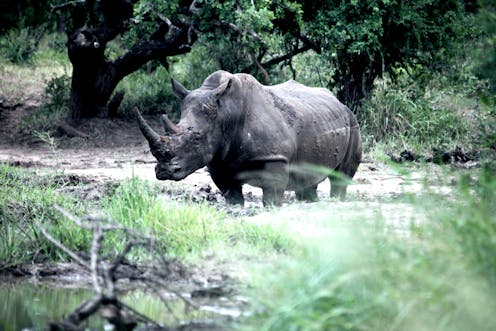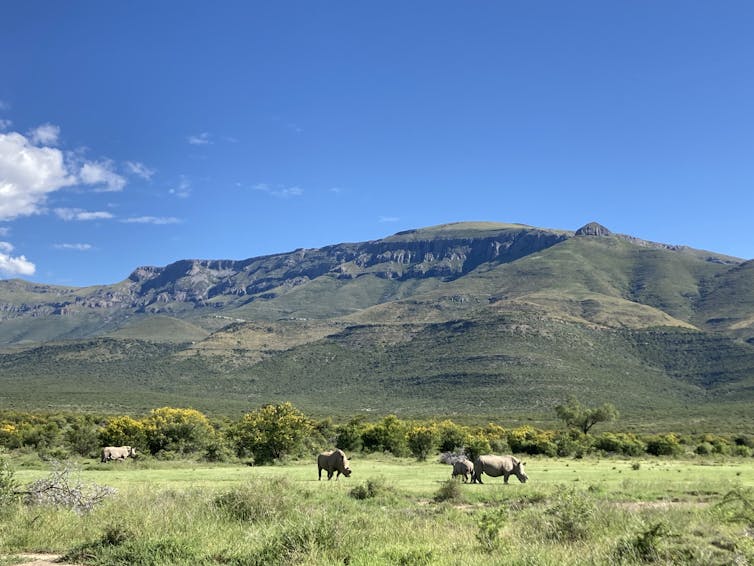
Southern white rhinos are widely known as a conservation success story. Their population grew from fewer than 100 individuals in the 1920s to 20,000 in 2012, mostly in South Africa.
This success was partially due to the inclusion of the private sector, which started in the 1960s when white rhinos were moved from their last remaining population in Hluhluwe-iMfolozi Park and placed in other state reserves as well as on private land. In 1991 the Game Theft Act formalised conditions for private rhino ownership and use. Poaching pressure was low at the time, and the demand for rhinos by ecotourists and trophy hunters gave private landowners incentives to grow their rhino populations.
Based on publicly available data, our recent paper shows that, today, private landholders conserve over half of South Africa’s white rhinos. Communities conserve a further 1% of the white rhinos. This trend is not unique to South Africa. More than 75% of Zimbabwe’s and Namibia’s white rhinos are on private lands. Although outside their natural range, in east Africa 72% of Kenya’s white rhino populations are conserved by private landowners.
In South Africa, the increasing contribution of private rhino custodians over the past few decades is partly due to their success and partly due to shrinking rhino populations in key state parks. Poaching is largely to blame for shrinking populations. A decade ago, the 2-million-hectare Kruger National Park held over half of the world’s 20,000 white rhinos. Today the park has just over 2,000 of the remaining 16,000 white rhinos. Kruger lost 6% of its population to poaching in 2020 alone. Hluhluwe-iMfolozi Park has suffered similar declines.
Private ranches in South Africa, meanwhile, lost just 0.5% of their rhinos to poaching in 2020. This is likely because smaller private properties are easier to secure and because private ranchers spend more per rhino on security – R28,600 (US$2200) per rhino in 2017, compared with an estimated R8,600 (US$520) per rhino spent by South African National Parks.
This high spend on security may have reduced poaching risk, but it has also reduced the benefits accrued from owning rhinos. Even for rhino owners who are not financially motivated, the growing costs of protecting rhinos from poaching are difficult to sustain.
In our paper, we outline potential policy pathways to support rhino conservation beyond state parks. Additional revenue streams are needed to give private and community rhino custodians the incentive. These could include tapping into markets beyond ecotourism and trophy hunting, such as carbon and biodiversity credits. Incentives could also include private sector funding through impact investments, and government funding through tax incentives. New community custodians are likely to require state support, at least initially.
As large grazers, rhinos play an important role in their ecosystem. Their decline is evoking strong sentimental reactions from people around the world. This raises the question: to what extent should the costs of protecting globally valued rhinos be carried by their local custodians?
The cost is too high
In 2018 we estimated that 28% of private rhino owners in South Africa were disinvesting, while 57% were continuing as usual and 15% were investing in more rhinos.
At that time rhino breeder John Hume was one of the flagship investors. He and some other private rhino owners had been investing in rhinos in the hope that rhino horn trade would be legalised, which would make the cost-benefit ratio of owning rhinos considerably more favourable.
But in April 2023, Hume held an online auction to sell the 2,000 white rhinos he owned – representing about 13% of the continental population. He said he could no longer afford his costly rhino breeding operation. The auction failed to attract any bidders.
There are three possible outcomes for Hume’s rhinos. One, a buyer could take over the operation. Two, the animals could be relocated to parks in South Africa or other countries in sub-Saharan Africa. Or they might be relocated abroad, beyond their historical range (for instance to Asia or Australia).
The first outcome would be the simplest. But it doesn’t solve the problem that rhinos are increasingly expensive to support.
The second option is attractive because it would boost population numbers in parks that have lost their populations. However, the “space” for rhinos in many of these parks likely signals their failure at protecting their rhinos in the first place. Rewilding would require a new strategy for protecting them.
Moving rhinos beyond their historical range has been considered before. A multi-million-dollar proposal to move rhinos to Australia (where they do not naturally occur) received support but also criticism. Almost 1,000 white rhinos are already in captivity around the world and such projects arguably divert funds and expertise away from conservation efforts in the countries where rhinos naturally occur.
It’s important to consider how to support private rhino custodianship so that we don’t end up with more rhinos for sale that no one wants to buy.
Innovative solutions, partnerships
A diversity of models and a common vision is needed to conserve thriving populations of rhinos across state, private and community land.
Rhinos should not unjustly burden those who serve as their custodians. Income from ecotourism and trophy hunting is insufficient under current poaching conditions and costs. How can the cost-benefit ratio of conserving rhinos be shifted?

Legalising international horn trade would certainly shift the ratio, but there is strong pushback. At best horn trade is a medium-term solution since international policy moves slowly.
Additional, nearer-term options include rhino credits and impact bonds – large-scale philanthropy that pays for conservation success.
There is growing evidence that wildlife populations can increase soil carbon – possibly enabling wildlife ranches to tap into carbon credit markets. The government can also recognise and support the role of rhino custodians through tax incentives. South Africa is a pioneer in biodiversity stewardship tax incentives, though they are currently only available to landowners who formally declare their land as protected.
Time is running out for rhinos: more inclusive, equitable and innovative solutions are needed to support their conservation.
Hayley Clements receives funding from a Jennifer Ward Oppenheimer Research Grant and Kone Foundation.
Dave Balfour is a freelance ecologist and a member of the IUCN SSC African Rhino Specialist Group and Chairs the SADC Rhino Management Group.
Enrico Di Minin receives funding from the European Research Council – EU's Horizon 2020 Research and Innovation Program (grant agreement 802933).
This article was originally published on The Conversation. Read the original article.







